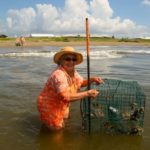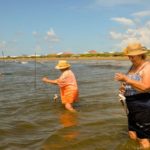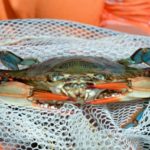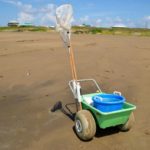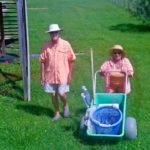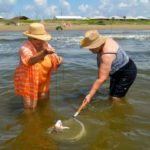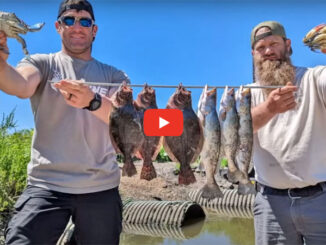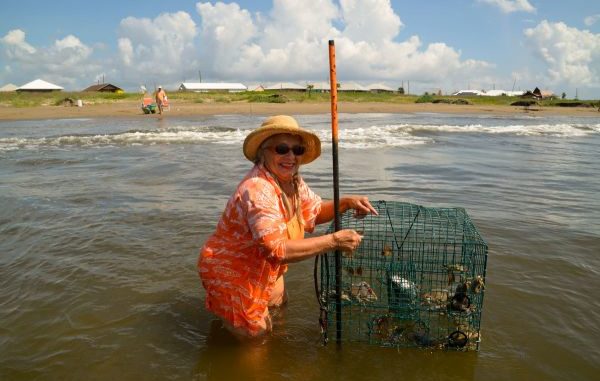
If you’re looking for something a big more relaxing to do on Grand Isle this month, lounge on the beach while catching the makings of a succulent crab boil Here’s all you need to know.
My wife Glenda told Barbara Picard that blue crab meat can make anything you cook taste better.
“Oooh, yes,” Barbara gushed. “You need to come to our camp on Grand Isle when the crabs are running. We can catch all we need, right off the beach. We won’t need a boat.”
“When would that be?” asked Glenda.
“July is best,” she answered. “I have all the equipment we need — crab traps and crab nets — and we will make a crab trotline. Afterward, we will boil some.”
Barbara turned slightly toward her soft-spoken, courtly husband, Les.
“Les, you need to be there. I might need help,” she said, waving her fingers with a patrician air.
Les’ eyes twinkled, but he didn’t say a word: He had just received his marching orders. Barbara Wurzlow Picard is a formidable, if incredibly charming woman.
Barbara thought a moment, as if checking to see if she missed anything, then turned to me, beaming.
“Jerald, It’s OK if you come too,” she said.
In spite of clearly seeing what the pecking order would be in this caper — and that Les and I clearly weren’t going to hold alpha or beta position — I couldn’t resist it.
It was fishing, and there had to be a story there.
When we got there, Barbara told us that she had put out two crab traps the day before so they could fish overnight.
Les rolled a handy Roleez beach push cart out from under the elevated camp and loaded it with two folding chairs, a small ice chest with beverages, drop nets, dip nets and trotline-making supplies.
From the camp, it was a very short jaunt across the road, over the sand levee fronting the beach and onto the beach itself. The huge, inflated tires of the Roleez cart made pushing the load on the sand a snap.
“I first saw a surf fisherman with one,” Les said of the cart. “He had his live cocahoe minnows swimming in it. I found one on the Internet and ordered it.”
Crabbing here was easy-access, but it wasn’t going to be a wilderness experience. Families were already lolling around on the beach, some in the sun and some under beach tents. Kids were splashing in the water, some building sand castles; a number of people were surf-fishing, belly-deep in the water.
Under Barbara’s expert direction, the two girls built their trotline. They waded out over a submerged sandbar and into a deeper trough of water.
A little further out, another sandbar extended parallel to the first bar and trough, but Barbara directed that crabbing is best in the trough between those bars.
They stabbed two metal pipes a distance apart in the sand and stretched a length of heavy nylon twine between them, tying off to each pipe well above the water line.
Barbara and Glenda tied droppers to the mainline spaced 8 to 10 feet apart. Barbara used simple square knots; Glenda used hatchet knots (for the uninitiated, these are knots that are impossible to untie unless a hatchet is used.)
Each of the droppers were simple affairs, a 4-foot length of nylon twine to one end of which a weight (old railroad spikes are great) was tied.
The bait used to lure the crabs to their doom was tied to the line immediately above the weight.
Barbara selected chicken parts as bait, only because turkey necks — her favorite — were not available.
“Turkey necks hold on the line better and last all day,” she explained. “Chicken parts are more expensive. Fish heads and skeletons are good bait, too.”
Barbara uses the same baits for trotlines, set nets and crab traps.
Les, his engineer’s mind clicking about efficiency, called Grand Isle crabbing part of a perpetual motion machine.
“You buy some cocahoe minnows and catch trout with them. You use the trout heads and skeletons to bait your crab traps,” he explained. “You break apart some of the crabs you catch and use them as bait in minnow traps set in marshy ditches on the backside of the island.
“You use the minnows you catch to catch more trout and repeat the cycle.”
He smiled with delight at the organization and order of the system.
After baiting and setting out set nets as the last piece of equipment, the girls retired to their folding chairs — what Barbara called essential items.
“Some ladies want beach umbrellas too, but I don’t need one,” she said.
The scene was seductively relaxing. The screeching of laughing gulls wheeling in the air punctuated the lull of the Gulf’s waves rolling in gently on Grand Isle’s tan beach sands.
Barbara interrupted the girls’ discussion about absolutely nothing of importance by looking up mischievously and asking a question with a feigned imperial air.
“Where’s my houseboy? I need a refreshment,” she said.
The ever-patient Les was up the beach, studying some bit of flotsam.
“Oh well,” Barbara sighed. “I guess I’ll have to get my own.”
Every 20 minutes or so, the girls would get up and wade into the surf to check the trotline and drop nets.
Barbara slowly eased each dropper to the surface. Glenda positioned a dip net beneath the bait as it neared the surface. Crabs clinging to the bait either dropped off or were shaken in the dip net.
The pair of crabbers would then wade back to shore, and Glenda would shake the catch from her landing net into a plastic champagne basket used to store the catch.
Between runs, Barbara took a moment to explain the merits of each type of fishing gear.
Crab traps are easier, she said.
“While I am entertaining,” she hooked a thumb toward her camp, “they are fishing.”
The main problem with traps, she said, is that they are best put out overnight. And a storm squall can make the surf rough enough to take them away.
People can also steal unattended traps.
She solved the storm problem by driving a stout piece of pipe or rebar through the mesh of each trap into the bottom, but theft can still occur.
She called trotlines the traditional way of crabbing — “the way we grew up.” They are less expensive than crab traps, but you have to be in the sun all day to fish them.
Drop nets can also be used in the surf, but are best to use off piers and wharfs, especially where you can’t reach to the water with a dip net to catch crabs holding onto bait on a string.
Drop nets used in the surf usually are rigged with small floats that can be grabbed to raise the nets.
Barbara uses a variety of dip nets of no particular brand for crabbing.
“I bought these at a salvage store, so that’s why I have these,” she said. “I just want my dip nets to have a long handle.”
Another important piece of equipment is a set of crab tongs because blue crabs are aggressive and have sharp pincers, and they don’t let go of flesh easily once they have clamped down on it.
Most tongs are made of steel, which rusts quickly when exposed to saltwater. A rinse after each use and an occasional oiling of the hinges will help keep them functioning.
Other accessories Barbara recommended besides a plastic champagne basket to hold the catch include sun block, sunglasses, ice water, a hat and water shoes.
“If you go barefoot, the crabs will get you,” she said.
Beach crabbing is a summertime activity, with the best months being July and August.
“They run better those months,” Barbara explained. “The weather is nice, too — if we don’t get a hurricane.”
Crabbing with trotlines and drop nets is best, if you can so plan it, on incoming tides. Crab traps, of course, fish round the clock as long as they are in the water.
Grand Isle’s beaches are publicly owned. According to Barbara, they are accessible by entryways over the levee between camps. Most have off-road parking spots that are essentially rights-of-way extensions of the island’s north-south streets that bisect Highway 1.
After a couple of hours, Barbara and Glenda declared they had caught enough to eat. They took down their trotline and hauled their crab traps to the beach.
There, Les emptied the traps into their basket, and hauled the crabs and equipment across the road to the camp.
The first order of business for Les, even before he hosed off their crabbing equipment, was to dump the crabs in a galvanized washtub and give them a thorough hosing to wash off beach sand.
The girls showered and changed clothes, and then retreated to the cool, shady sanctuary of the screened porch beneath the camp.
“When I was a young girl,” Barbara mused, “my dad would take me crabbing with a long line (aka trotline) on the beach. My mother would fry hard crabs. She made an Italian crab salad with a recipe that she got from Nat Chighizola. He made a crab spaghetti — oh, it was so good! I would ask him to make it for me all the time.
“I always say that I wish it was the way it used to be. You could drive cars on the beach then. My father said that when they built those levees along the beach they took the romance away from the island. He died last year, a few months shy of 100. My mother wouldn’t come back to the island after the levee was built.”
She paused for a moment, and then moved to the present.
“Crabbing is a common thing on the island,” Barbara said. “My friends all crab. We don’t buy crabs; we catch all our own. We have 10 traps, but don’t really need that many.
“We are so lucky.”
“Yes,” Glenda agreed. “We get to catch our own dinner.”
